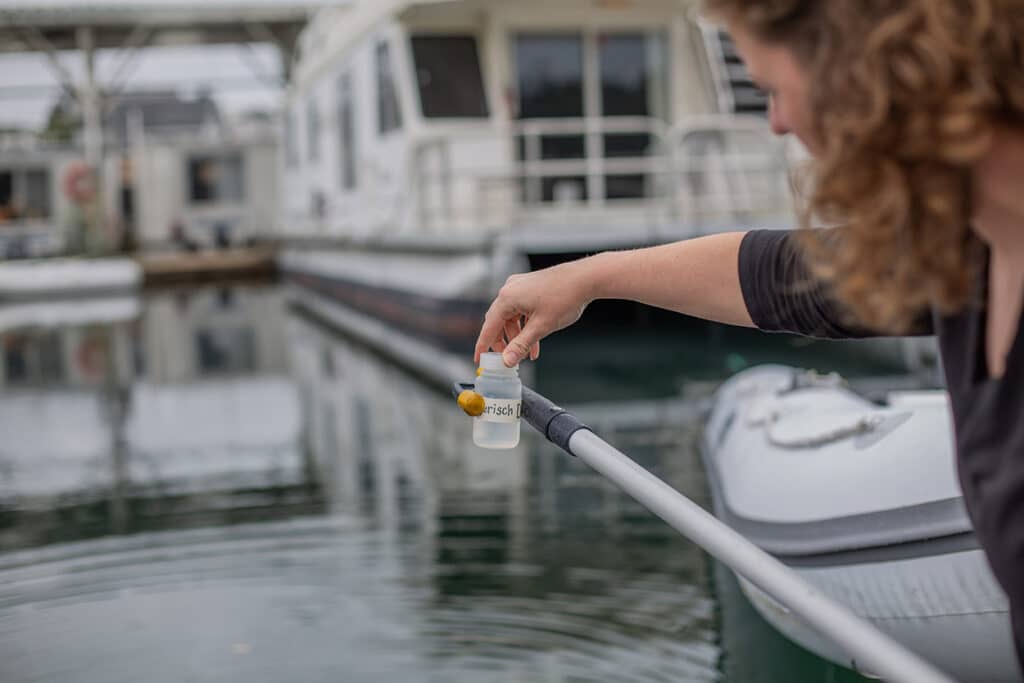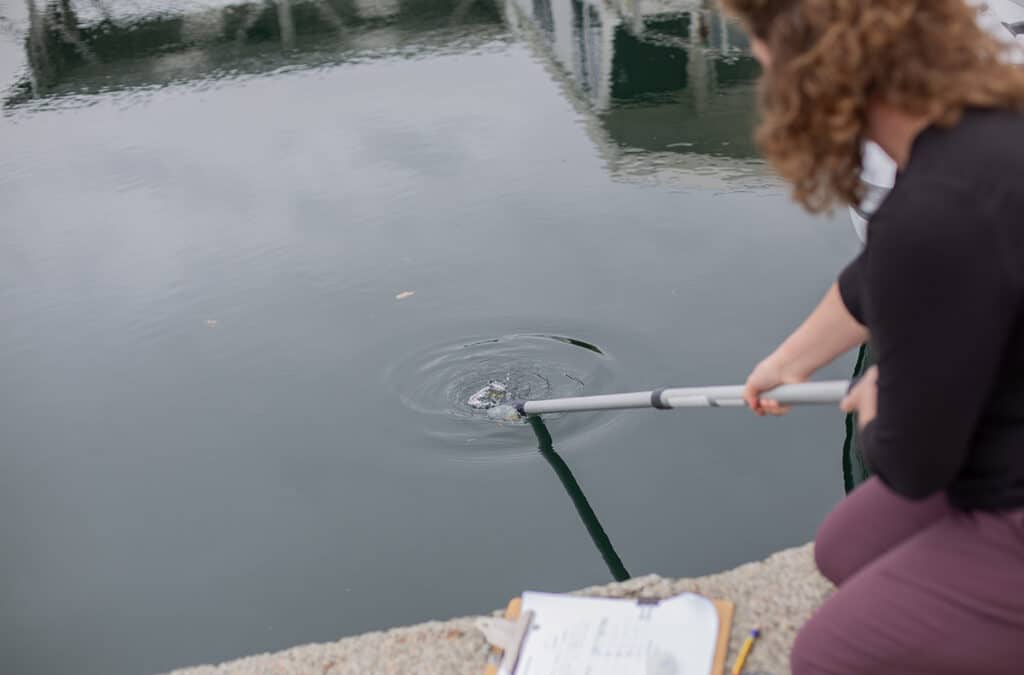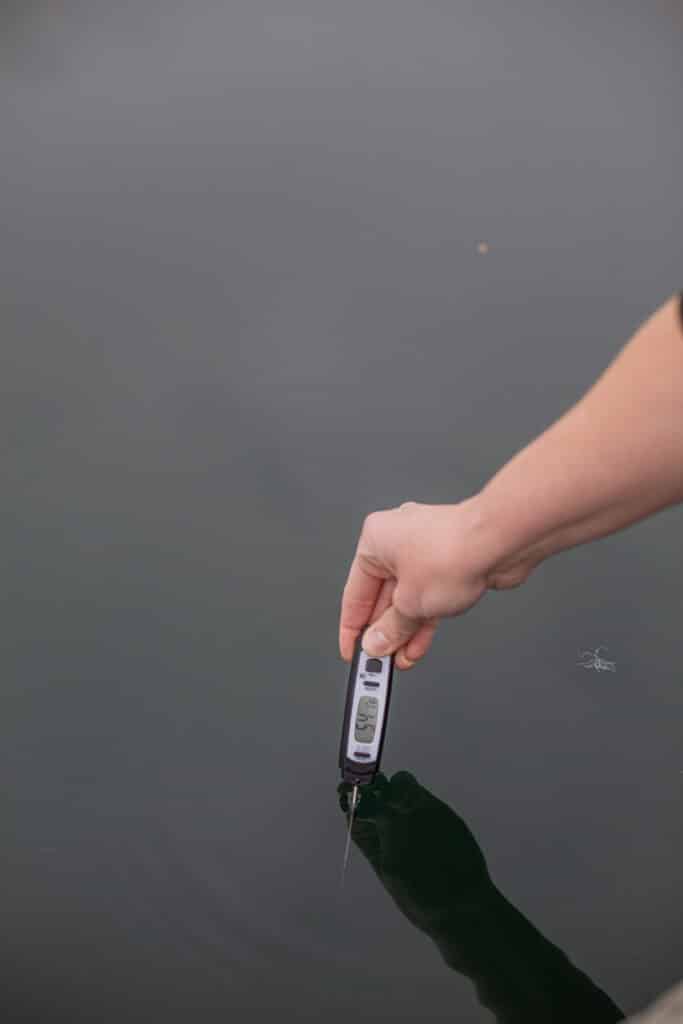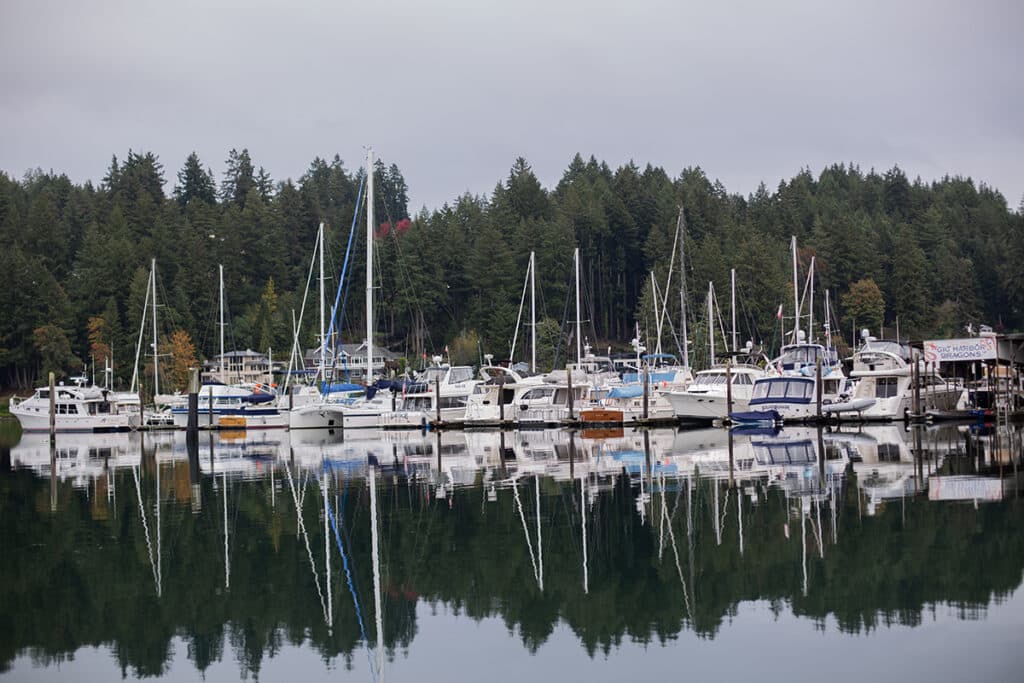Community Environment
Harbor WildWatch helps the Blue Water Task Force keep the water clean
“When I was here, the harbor seal just went right under the dock and popped up on the other side,” Sarah Kelly excitedly says. Her eyes sparkle. “It was so close.”
On this temperate day in early October, Kelly takes a sample of the water at Jerisich Dock. She is a Blue Water Task Force volunteer, collecting samples for Gig Harbor’s aquatic conservation nonprofit, Harbor WildWatch. (If you haven’t seen Harbor WildWatch, just keep an eye out for the colorful inflatable tentacles, which cheerfully wave to passersby from a window on a building along the waterfront. They’re hard to miss.)
Harbor WildWatch is one of many organizations involved in Blue Water Task Force, a 25-year-old water health initiative spearheaded by the Surfrider Foundation. Surfrider is a nonprofit grassroots organization started in 1984 by a group of Malibu, California, students who were concerned about the environmental conditions of the waters in which they surfed, due to coastal development.

Volunteer Sarah Kelly takes a water sample at Jerisich Dock in Gig Harbor on Oct. 8, 2024. Photo by Carolyn Bick.
Harbor WildWatch and the Blue Water Task Force
South Sound Surfrider’s Washington Regional Manager Liz Schotman said that the Blue Water Task Force has been around since at least 1990, likely starting in Ventura, California.
Sampling data took a bit of a dip due to labs shutting down during the first couple years of the pandemic, Schotman said. But the foundation has overall seen a steady growth in sampling teams. Currently, Blue Water Task Force collects just shy of 10,000 annual samples throughout the continental U.S., Hawai’i and Puerto Rico.
Harbor WildWatch is one of the organizations that tests for the South Sound chapter of Surfrider. They test the waters from September through May — filling the Washington state Department of Ecology’s “gap” season — so that people who wade into local waters year-round know where it is safe to swim, plunge, boat and play.
Harbor WildWatch gathers water to test from 10 sites in both Gig Harbor and Tacoma (they usually sample 11 sites, but one site, Kopachuck State Park, is under construction until 2025). Gathering a sample is relatively simple, but the data the sampling provides is informative.
Testing for bacteria
Harbor WildWatch’s science director, Stena Troyer, has worked with Blue Water Task Force since 2014 and became a program coordinator within the last few years. She said that they test for enterococcus bacteria levels, which tells them how much fecal matter is in the water. All animals’ feces, including humans, contains this kind of bacteria.
The samples are sent to a lab at SaMI, which stands for the Science and Math Institute. Tacoma Public Schools operates SaMI, a high school lab space, out of Point Defiance Park. If the lab finds a high level of bacteria in a sample, Troyer said, they retest the site to make sure. Sometimes, a dead animal in the water near the collection site fouled the sample. The task force uses the clean water thresholds set out by the Environmental Protection Agency (EPA).

Volunteer Sarah Kelly takes a water sample at Jerisich Dock in Gig Harbor on Oct. 8, 2024. Photo by Carolyn Bick.
If the results come back showing high bacteria levels again, Troyer said, they contact the Tacoma-Pierce County Health Department, as well as the state’s Beach Environmental Assessment, Communication & Health (BEACH) program, created under the EPA-guided federal BEACH Act. Health department officials then re-test the water themselves. They have to do this, Troyer explained, because SaMI is not accredited to provide official water quality results.
But this doesn’t mean that the results from SaMI aren’t accurate. Troyer noted that “one of the things that is coming out of that [cooperative effort] is the Thea Foss Floating Dock site is gonna get a permanent advisory that basically says whenever there’s rain don’t go here because it will be crappy.” (So to speak.)
Seasonal changes
Small jokes aside, this forthcoming advisory is a prime example of why it is important to sample year-round. Troyer said they find less bacteria in the water during warmer, drier months. The rainy months have a significantly higher amount of bacteria, due to land runoff that builds up and marinates in the summer sun for months on end.
Sometimes, though, it’s not due to expected seasonal occurrences, and testing the water is not just for human health alone. It can also lead to environmental campaigns to clean up or better care for an area. Schotman described a 2017 victory at Bellingham’s Larrabee State Park, where the Northwest Straits chapter had for years routinely gotten high bacterial results for no discernible reason.

Volunteer Sarah Kelly takes the temperature of the water at Jerisich Dock in Gig Harbor on Oct. 8, 2024. Photo by Carolyn Bick.
As it turned out, the answer was some very attractive garbage.
“[The Northwest Straits Chapter] realized that people were not taking care of their garbage very well, and there’s a lot of raccoons and they have a latrening behavior where they hang out in the waterways and poop in the streams upland from the beach area,” Schotman said. “By just doing a better job managing trash at the park, they were able to fix the problem. That’s the other benefit in addition to just protecting public health and making sure people are safe when they’re swimming. There’s this opportunity to identify chronic problems and figure out how to fix them.”
Keeping the water clean
And it’s these solutions to chronic problems that the Blue Water Task Force can identify that Surfrider tries to get the federal government to recognize. Schotman said that every two years, like clockwork, she and other folks at Surfrider fly to Washington, D.C., to push Congress to fully fund the BEACH Act. She said that federal funding — or lack thereof — “is what is limiting our local states’ ability to fully test our waters all year and in all places.”
Schotman also said that they advocate for Congress to fund the Clean Water State Revolving Fund. Like the BEACH Act, it’s a federal pot of money distributed amongst different states, aimed at improving aging infrastructure, like wastewater treatment plants and stormwater management facilities.
“We have a lot of old outdated infrastructure here in Washington and all over the country, and we need federal funding to upgrade, to make these necessary upgrades that have huge benefits to our coastal water quality beyond just public health,” Schotman said. “That improves salmon habitat and acidification issues and things like that.”

Boats on the water at Jerisich Dock in Gig Harbor on Oct. 8, 2024. Photo by Carolyn Bick.

